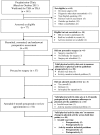Do activity levels increase after total hip and knee arthroplasty?
- PMID: 24353051
- PMCID: PMC3971219
- DOI: 10.1007/s11999-013-3427-3
Do activity levels increase after total hip and knee arthroplasty?
Abstract
Background: People with osteoarthritis (OA) often are physically inactive. Surgical treatment including total hip arthroplasty or total knee arthroplasty can substantially improve pain, physical function, and quality of life. However, their impact on physical activity levels is less clear.
Questions/purposes: We used accelerometers to measure levels of physical activity pre- and (6 months) postarthroplasty and to examine the proportion of people meeting the American Physical Activity Guidelines.
Methods: Sixty-three people with hip or knee OA awaiting arthroplasty were recruited from a major metropolitan hospital. Physical activity was measured using accelerometry before, and 6 months after, surgery. The ActiGraph GT1M (ActiGraph LLC, Fort Walton Beach, FL, USA) was used in this study and is a uniaxial accelerometer contained within a small activity monitor designed to measure human movement through changes in acceleration, which can then be used to estimate physical activity over time. Questionnaires were used to assess patient-reported changes in pain, function, quality of life, and physical activity. Complete data sets (including valid physical activity data) for both time points were obtained for 44 participants (70%). At baseline before arthroplasty, the activity level of patients was, on average, sedentary for 82% of the time over a 24-hour period (based on accelerometry) and self-rated as "sometimes participates in mild activities such as walking, limited shopping, and housework" according to the UCLA activity scale.
Results: There was no change in objectively measured physical activity after arthroplasty. The majority of participants were sedentary, both before and after arthroplasty, and did not meet the American Physical Activity Guidelines recommended to promote health. This was despite significant improvements in self-reported measures of pain, function, quality of life, and physical activity after arthroplasty.
Conclusions: Despite patient-reported improvements in pain, function, and physical activity after arthroplasty, objectively measured improvements in physical activity may not occur. Clinicians should incorporate strategies for improving physical activity into their management of patients after hip and knee arthroplasty to maximize health status. Future research is needed to explore the factors that impact physical activity levels in people after arthroplasty.
Level of evidence: Level IV, therapeutic study. See Guidelines for Authors for a complete description of levels of evidence.
Figures


Comment in
-
Reply to the Letter to the editor: Do activity levels increase after total hip and knee arthroplasty?Clin Orthop Relat Res. 2014 Sep;472(9):2891-2. doi: 10.1007/s11999-014-3743-2. Epub 2014 Jun 25. Clin Orthop Relat Res. 2014. PMID: 24962495 Free PMC article. No abstract available.
-
Letter to the editor: Do activity levels increase after total hip and knee arthroplasty?Clin Orthop Relat Res. 2014 Sep;472(9):2889-90. doi: 10.1007/s11999-014-3742-3. Epub 2014 Jun 26. Clin Orthop Relat Res. 2014. PMID: 24964888 Free PMC article. No abstract available.
References
-
- Impairments and Disability Associated With Arthritis and Osteoporosis. Canberra, Australia: Australian Institute of Health and Welfare; 2007.
-
- ActiGraph. ActiGraph GT1M Monitor/ActiTrainer and ActiLife Lifestyle Monitor Software User Manual. Fort Walton Beach, FL, USA: ActiGraph; 2007.
-
- Ainsworth BE, Haskell WL, Whitt MC, Irwin ML, Swartz AM, Strath SJ, O’Brien WL, Bassett DR, Jr, Schmitz KH, Emplaincourt PO, Jacobs DR, Jr, Leon AS. Compendium of physical activities: an update of activity codes and MET intensities. Med Sci Sports Exerc. 2000;32:S498–504. doi: 10.1097/00005768-200009001-00009. - DOI - PubMed
-
- Treatment of Osteoarthritis of the Knee: Evidence-based Guideline. 2. Rosemount, IL, USA: American Academy of Orthopaedic Surgeons; 2013. - PubMed
-
- Australian National Joint Replacement Registry Annual Report. Adelaide, Australia: Australian Orthopaedic Association; 2011.
MeSH terms
LinkOut - more resources
Full Text Sources
Other Literature Sources
Medical
Research Materials

